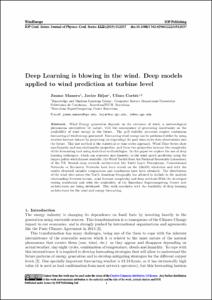Mostra el registre d'ítem simple
Deep learning is blowing in the wind. Deep models applied to wind prediction at turbine level
| dc.contributor.author | Manero Font, Jaume |
| dc.contributor.author | Béjar Alonso, Javier |
| dc.contributor.author | Cortés García, Claudio Ulises |
| dc.contributor.other | Universitat Politècnica de Catalunya. Departament de Ciències de la Computació |
| dc.date.accessioned | 2019-06-25T09:28:40Z |
| dc.date.available | 2019-06-25T09:28:40Z |
| dc.date.issued | 2019 |
| dc.identifier.citation | Manero, J.; Béjar, J.; Cortés, U. Deep learning is blowing in the wind. Deep models applied to wind prediction at turbine level. A: WindEurope Conference and Exhibition. "Journal of physics: conference series, vol. 1222, Maig 2019, article 012037". Londres: Institute of Physics (IOP), p. 1-11. |
| dc.identifier.isbn | 1742-6596 |
| dc.identifier.uri | http://hdl.handle.net/2117/135298 |
| dc.description.abstract | Wind Energy generation depends on the existence of wind, a meteorological phenomena intermittent by nature, with the consequence of generating uncertainty on the availability of wind energy in the future. The grid stability processes require continuous forecasting of wind energy generated. Forecasting wind energy can be performed either by using weather forecast data or by projecting (or regressing) the past time-series data observations into the future. This last method is the statistical or time series approach. Wind Time Series show non-linearity and non-stationarity properties, and these two properties increase the complexity of the forecasting task using statistical methodologies. In this paper we explore the use of deep learning techniques, which can represent non-linearity, to the wind speed prediction using the largest public wind dataset available, the Wind Toolkit from the National Renewable Laboratory of the US. Several deep network architectures like Multi Layer Perceptrons, Convolutional Networks or Recurrent Networks have been tested on the 126,692 wind-sites and with the results obtained valuable comparisons and conclusions have been obtained. The distribution of the wind sites across the North American Geography has allowed to include in the analysis relationships between terrain, wind forecast complexity and deep methods. With the developed testing workbench and with the availability of the Barcelona Supercomputing Center new architectures are being developed. This work concludes with the feasibility of deep learning architectures for the wind and energy forecasting. |
| dc.format.extent | 11 p. |
| dc.language.iso | eng |
| dc.publisher | Institute of Physics (IOP) |
| dc.rights | Attribution 3.0 Spain |
| dc.rights.uri | http://creativecommons.org/licenses/by/3.0/es/ |
| dc.subject | Àrees temàtiques de la UPC::Informàtica::Intel·ligència artificial::Aprenentatge automàtic |
| dc.subject | Àrees temàtiques de la UPC::Energies::Energia eòlica |
| dc.subject.lcsh | Machine learning |
| dc.subject.lcsh | Weather forecasting |
| dc.subject.lcsh | Wind power |
| dc.subject.other | Complex networks |
| dc.subject.other | Network architecture |
| dc.subject.other | Time series |
| dc.subject.other | Convolutional networks |
| dc.subject.other | Learning architectures |
| dc.subject.other | Meteorological phenomena |
| dc.subject.other | Multi-layer perceptrons |
| dc.subject.other | Statistical methodologies |
| dc.subject.other | Supercomputing centers |
| dc.subject.other | Wind energy generation |
| dc.subject.other | Wind speed prediction |
| dc.subject.other | Deep learning |
| dc.title | Deep learning is blowing in the wind. Deep models applied to wind prediction at turbine level |
| dc.type | Conference report |
| dc.subject.lemac | Aprenentatge automàtic |
| dc.subject.lemac | Previsió del temps |
| dc.subject.lemac | Energia eòlica |
| dc.contributor.group | Universitat Politècnica de Catalunya. KEMLG - Grup d'Enginyeria del Coneixement i Aprenentatge Automàtic |
| dc.identifier.doi | 10.1088/1742-6596/1222/1/012037 |
| dc.description.peerreviewed | Peer Reviewed |
| dc.relation.publisherversion | https://iopscience.iop.org/article/10.1088/1742-6596/1222/1/012037/meta |
| dc.rights.access | Open Access |
| local.identifier.drac | 25184078 |
| dc.description.version | Postprint (published version) |
| dc.relation.projectid | info:eu-repo/grantAgreement/MINECO//TIN2015-65316-P/ES/COMPUTACION DE ALTAS PRESTACIONES VII/ |
| dc.relation.projectid | info:eu-repo/grantAgreement/AGAUR/V PRI/2014 SGR 1051 |
| local.citation.author | Manero, J.; Béjar, J.; Cortés, U. |
| local.citation.contributor | WindEurope Conference and Exhibition |
| local.citation.pubplace | Londres |
| local.citation.publicationName | Journal of physics: conference series, vol. 1222, Maig 2019, article 012037 |
| local.citation.startingPage | 1 |
| local.citation.endingPage | 11 |


